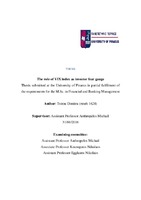The role of VIX index as investor fear gauge

View/
Keywords
VIX index ; Futures ; CBOE ; Forecasting ; Cointegration ; Enger-GrangerAbstract
This thesis focuses on the VIX index, also called the investors’ fear gauge. The VIX index is a volatility index that is supposed to express the market expectations about the 30-day volatility. It has been created by CBOE (Chicago Board Option Exchange) in 1993. Soon after its creation, CBOE also created several derivatives written on VIX. The investors’ fear gauge has drawn both academics’ and practitioners’ attention ever since it was first introduced. Nowadays the index has become really important especially for investors. It can be used as a measure of market’s predictions about the S&P 500 fluctuations in 30 days ahead. It can also be used to hedge the risk of investments by taking the opposite position of which it has open and, for speculation reasons, as an investor can bet on the increase or the decrease of the index.
In this thesis, we study the relation between the VIX index and the futures contract written on it. We present historical volume data and we then concentrate on the causality between VIX spot and VIX futures. The controversial issue of whether the price of the VIX spot can predict the price of the VIX future (and vise versa) is extensively analyzed. In order to support our assumptions and verify our results, we use two econometric methods. The Linear Engle-Granger cointegration and the resulting model, which is known as a vector error correction model (VECM).


